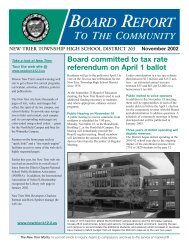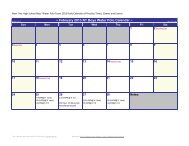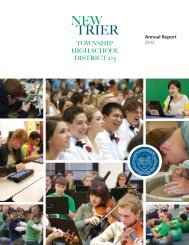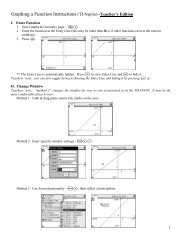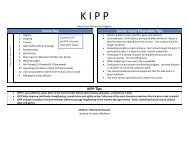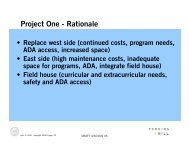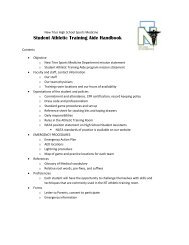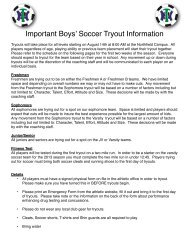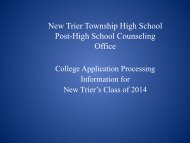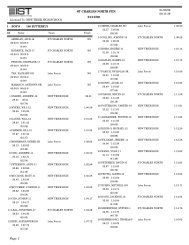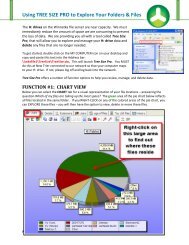Intro to O.M.T. - New Trier Township High School
Intro to O.M.T. - New Trier Township High School
Intro to O.M.T. - New Trier Township High School
- No tags were found...
You also want an ePaper? Increase the reach of your titles
YUMPU automatically turns print PDFs into web optimized ePapers that Google loves.
Learning ObjectivesReview Key Concepts behind OMTList at least 3 types of ManipulationDemonstrate competence diagnosingMechanical Back PainPerform manipulative therapy on Neck,Shoulder, Ankle, Upper back, Lower backand SacrumUse these skills <strong>to</strong> help your athletes
Basis of Manipulation“Osteopathy is nottreatingdiseases, it istreating people”A.T. Still, M.D. -1892
Concept AThe Body is a Unit
Concept BStructure and Function arereciprocally interrelated
The function of every tissuein the body is <strong>to</strong> moveEach part of the human body isdesigned <strong>to</strong> function efficientlyin relationship with every otherpart
Concept CThe Body possessesSelf-Regula<strong>to</strong>ryMechanisms
Concept DThe Body has the InherentCapacity <strong>to</strong> Defend andHeal itself
Concept EIf environmental changesOvercome the body’scapacity for selfmaintenance, diseasemay ensue
Concept FMovement of bodyfluids is essential <strong>to</strong>the maintenance ofhealth
Concept GNerves play a crucial partin controlling the fluids ofthe body
Concept HThere are SomaticComponents of disease whichnot only manifest disease butalso contribute <strong>to</strong> maintenanceof the diseased state
Musculoskeletal SystemProvides frameworkPathway for:– vascular system– neural system– lymphatic system
FasciaConnective tissue layersContinuous from the base of skull<strong>to</strong> the feetLike taut curtains throughout thebodyThink Ana<strong>to</strong>mically
Joint Ranges of MotionThree planes ofmotion– Flexion/Extension– Side bending(lateralrotation)– Rotation
Joint Ranges of MotionSide bending mustinduce rotationCervical spine– Motions occur in samedirectionsThoracic and Lumbarspine– Motions occur inopposite directions
Joint Ranges of MotionFlexion/Extension– limits side bendingand rotationThe abnormal jointmotion is the“OsteopathicLesion”
Osteopathic LesionDisturbance of Structure whichimpairs normal physiologicMotion and thereby interfereswith efficient Function
Somatic DysfunctionImpaired or altered function ofrelated components of the somaticsystem. (Body frame-work)– Skele<strong>to</strong>n, Joints and Myofascial structures– Vascular, Lymphatic and Neural elementsHospital Adaptation of the International Classification ofDisease, 2007. (ICD-9-CM CM 739.0-739.9)739.9)
Range of PassiveMotionMidline NeutralElastic BarrierParaphysiologic SpaceAna<strong>to</strong>mic Barrier
Range of Active MotionMotion loss due <strong>to</strong>Myofascial Shorteningmidline neutralPhysiologic BarrierElastic BarrierAna<strong>to</strong>mic Barrier
Minimal Motion LossActive MotionAvailable MotionLossPhysiologic BarrierMidlineneutralElastic BarrierAna<strong>to</strong>mic BarrierRestrictive Barrier
Conceptual SummaryThe body must move <strong>to</strong> maintain healthDecreased motion = DecreasedfunctionDecreased function = Increased painOsteopathic Manipulative Therapy– Res<strong>to</strong>res Motion– Increases Function– Decreases Pain
Manipulation in AcuteLow Back PainReview of good quality large systematicreviewsStatistically significant shortening ofrecovery time occurred in manipulationgroup compared <strong>to</strong> ALL OTHER treatmentmethodsCochrane Review, 2004;(1): CD000447Spine J, 2004; 4:335-56.56.J Manip Phys Th, 2003;26: 593-601.Eur Spine J, 2006;15: s64-81.
Mechanical Low Back PainReview of good quality large controlledsystematic reviewsShort term pain scores significantly improvedwith manipulationPatients reported greater improvement in sittingand ADL’s s ( p < .01)Long term benefits were not seen (NS)Cochrane Review, 2004;(1): CD000447Spine J, 2004; 4:335-56.56.J Manip Phys Th, 2003;26: 593-601.
Sciatica Pain at 6 months102 subjects with acute low back pain andsciaticaCompared true manipulation <strong>to</strong> shammanipulationFollowed subjects for 6 monthsSignificant improvement with true spinalmanipulation (p < .05)Santilli, Beghi, Finucci.SpineJ, , 2006; 6: 131-7.
Attitudes Toward Manual Medicine,Implications for CMEManual medicine is a physical modality infrequentlyused in primary care clinicsStudy looked at Physician and Patient attitudes<strong>to</strong>ward MM– 81% Physicians & 76% Patients, felt it was safe– 56% Physicians & 59% Patients, thought it should bemore available– 71% of Physicians desired CME trainingS<strong>to</strong>ll ST, et.al, J Cont Educ Health Prof, , 2003;23(1):13-20
Well, Teach Me!We will learn directed diagnostic testsDirect and Indirect Techniques, such as:– Muscle energy– Counterstrain– Fascia release
10 Step Screening ExamStep 2: StandingPatientPosture, Observe from:– Back, , level of ears,shoulders, scapula,iliac crests & greatertrochanters
10 Step Screening ExamStep 2: StandingPatientPosture, Observe from:– Front, level of eyes,ears, shoulders & ilia
10 Step Screening ExamStep 2: StandingPatientPosture, Observe from:– Side, , line up ears,shoulders, greatertrochanter & lateralmalleolus
10 Step Screening ExamStep 3:StandingSpinalMotionLumbarsidebending– Note symmetryof wherefingers contactknee
10 Step Screening ExamStep 3: StandingSpinal MotionStanding Flexion Test– Note symmetry ofmotion of PSIS– Rotation of <strong>to</strong>rso– Positive side is theone where the PSISmoves most
10 Step Screening ExamStep 5: SeatedFlexion TestNote symmetry ofmotion of PSISCompare results <strong>to</strong>standing flexion test
10 Step Screening ExamStep 5: SeatedFlexion TestNote symmetry of motionof PSISCompare results <strong>to</strong>standing flexion testPositive side is the onewhere the PSIS movesmost
Osteopathic TechniquesDirect– Move the joint through therestriction(directly res<strong>to</strong>ring physiologicmotion).– <strong>High</strong> Velocity/Low Amplitude– Muscle Energy
Osteopathic TechniquesMuscle Energy– Place the joint at the restrictive barrier, thepatient actively moves away from therestriction, but meets light resistance(3 pounds) from the opera<strong>to</strong>r– Patient then relaxes and the opera<strong>to</strong>r gentlymoves the patient in<strong>to</strong> the restrictive barrier– Repeat until motion is res<strong>to</strong>red
Osteopathic TechniquesMuscle Energy– Region at restrictivebarrier,– Patient actively movesaway from the restriction,– Opera<strong>to</strong>r applies lightresistance (3 pounds)– Patient relaxes,– Opera<strong>to</strong>r gently movespatient in<strong>to</strong> the restrictivebarrier– Repeat until motion isres<strong>to</strong>red
Apply this Technique <strong>to</strong> NeckMuscle Energy is a SAFE way <strong>to</strong> treatneck pain– Acute neck pain – Whiplash– Chronic neck pain – Pain in the Neck– Young and Healthy– Old and Osteoporotic
10 Step Screening ExamStep 6:CervicalRange ofMotionFlexion/Extension
10 Step Screening ExamStep 6:CervicalRangeofMotionRotation
10 Step Screening ExamStep 6:CervicalRange ofMotionSidebending
10 Step Screening ExamStep 6:CervicalRange ofMotionSupinePassiveFlexion/Extension
10 Step Screening ExamStep 6:CervicalRange ofMotionSupinePassiveRotation
Remember,Joint Ranges of MotionSidebending must induce rotationCervical spine– Motions occur in same directionsThoracic and Lumbar spine– Motions occur in opposite directions
Minimal Motion LossActive MotionAvailable MotionLossPhysiologic BarrierMidlineneutralElastic BarrierAna<strong>to</strong>mic BarrierRestrictive Barrier
Osteopathic TechniquesMuscle Energy– Region at restrictivebarrier,– Patient actively movesaway from the restriction,– Opera<strong>to</strong>r applies lightresistance (3 pounds)– Patient relaxes,– Opera<strong>to</strong>r gently movespatient in<strong>to</strong> the restrictivebarrier– Repeat until motion isres<strong>to</strong>red
Osteopathic TechniquesDirect– Move the joint through the restriction(directly res<strong>to</strong>ring physiologic motion).– <strong>High</strong> Velocity/Low Amplitude
10 Step Screening ExamStep 3: StandingSpinal MotionStanding FlexionTest– Note symmetry ofmotion of PSIS– Rotation of <strong>to</strong>rso– POSITIVE side isthe one wherethe PSIS movesmost
10 Step Screening ExamStep 5: SeatedFlexion TestNote symmetry of motionof PSISCompare results <strong>to</strong>standing flexion testPOSITIVE side is the onewhere the PSIS movesmost
Osteopathic TechniquesDirect (MuscleEnergy)– SI- Joint Pain (SacralTorsion)– Painful (+) side is theside that moves MOSTon tests– Position that sideDOWN
Osteopathic TechniquesMuscle Energy– Region at restrictivebarrier,– Patient actively movesaway from the restriction,– Opera<strong>to</strong>r applies lightresistance (3 pounds)– Patient relaxes,– Opera<strong>to</strong>r gently movespatient in<strong>to</strong> the restrictivebarrier– Repeat until motion isres<strong>to</strong>red
Osteopathic TechniquesIndirect– Move the joint away from the restriction, holdin that position– The fascial layers then return <strong>to</strong> their neutralposition and physiologic motion is res<strong>to</strong>red– Fascia Release & Counterstrain techniques
Fibromyalgia Pain ReliefAssociated with OMTRandomized trial with 4 treatment groups– OMT, OMT & Meds, Moist heat, Meds only– Outcomes:Standardized Pain scaleDepression scaleSelf Evaluation of ADL’s– Results: OMT & Meds most effective, OMT alone alsosignificantGambler RG, Shores JH, et. al. J Am Osteo Assoc2002:102:321-5
Osteopathic TechniquesIndirect (Strain/Counterstrain)– L. Jones, D.O.– Thumb palpatestender point– Move surroundingtissue until painresolves - Hold for90 seconds
Osteopathic TechniquesIndirect (Counterstrain(Counterstrain)– Thumb palpates tenderpoint– Move surrounding tissueuntil pain resolves - Holdfor 90 seconds– Gently return the patientback <strong>to</strong> neutral position– Goal is <strong>to</strong> completelyremove pain in targetedtissue
CPT codes for OMT98925 OMT of 1-212 Body Regions98926 OMT of 3-434 Body Regions98927 OMT of 5-656 Body Regions98928 OMT of 7-878 Body Regions98929 OMT of 9-109Body RegionsBody regions referred <strong>to</strong> are: Head, cervical,lumbar, sacral, pelvic, lower/upper extremities,rib cage and abdomenUse 25 modifier with E&M code
Further TrainingAmerican Academy of Osteopathy– 317-879879-1881– www.academyofosteopathy.orgAmerican Osteopathic Association– 800-621621-17731773 X 8252– www.aoa-net.org
SummaryKey Concepts behind OMT emphasizemotionManipulation includes direct and indirecttechniquesROM, Standing & Seated Flexion testshelp with diagnosisMany OMT techniques of the neck, upperback, lower back and sacrum are safe andeffective
Questions??My contact information.Troy Glaser, D.O.Resurrection Sports Medicine7447 W. Talcott Ave #182Chicago, IL 60631773-990990-7600 office303-549549-6947 cellEmail: troyaglaser@yahoo.com



